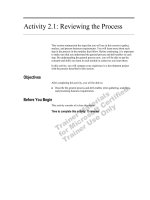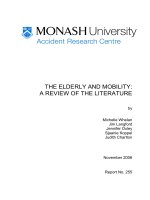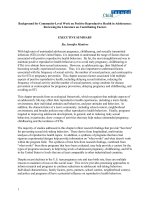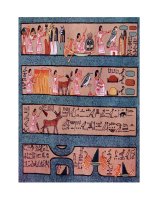Chreswell ch3 reviewing the literature
Bạn đang xem bản rút gọn của tài liệu. Xem và tải ngay bản đầy đủ của tài liệu tại đây (658.97 KB, 19 trang )
Chapter 3
Reviewing the Literature
This multimedia product and its contents are protected under copyright law. The following are prohibited by law:
any public performance or display including transmission of any image over a network; preparation of any derivative
work, including the extraction, in whole or in part, of any images; any rental, lease, or lending of the program.
Creswell, Educational Research: Planning, Conducting, and
Evaluating Quantitative and Qualitative Research, 4e
© 2012, 2008, 2005, 2002 Pearson Education, Inc.
All rights reserved.
By the end of this chapter,
you should be able to:
Define what a literature review is and
why it is important
Identify the five steps in conducting a
literature review
Educational Research: Planning, Conducting,
and Evaluating Quantitative and Qualitative
Research, 4e – Creswell
ISBN: 0132755912
3-2
© 2012, 2008, 2005, 2002 Pearson
Education, Inc.
All rights reserved.
What Is a Literature Review?
A written summary of the literature
Describes past and current information and
research
Organized into topics
Reports the literature based on themes or
individual studies
Documents a need for your proposed study
Educational Research: Planning, Conducting,
and Evaluating Quantitative and Qualitative
Research, 4e – Creswell
ISBN: 0132755912
3-3
© 2012, 2008, 2005, 2002 Pearson
Education, Inc.
All rights reserved.
Literature Review in a
Quantitative Study
Documents the importance of the research
problem at the beginning of the study
Supports the theory or explanation used in the
study
Foreshadows the research questions
Provides an explanation for the results in other
studies and in the theoretical prediction at the end
of the study
Educational Research: Planning, Conducting,
and Evaluating Quantitative and Qualitative
Research, 4e – Creswell
ISBN: 0132755912
3-4
© 2012, 2008, 2005, 2002 Pearson
Education, Inc.
All rights reserved.
Literature Review in a
Qualitative Study
Documents the importance of the research
problem at the beginning of the study
Does not foreshadow the research
questions (which are broad in scope to
encourage participants to provide their own
views)
Is used to compare and contrast with other
studies at the end of the study
Educational Research: Planning, Conducting,
and Evaluating Quantitative and Qualitative
Research, 4e – Creswell
ISBN: 0132755912
3-5
© 2012, 2008, 2005, 2002 Pearson
Education, Inc.
All rights reserved.
The Process of Conducting
a Literature Review
Identify key terms
Locate literature
Critically evaluate and select the literature
Organize the literature
Write a review
Educational Research: Planning, Conducting,
and Evaluating Quantitative and Qualitative
Research, 4e – Creswell
ISBN: 0132755912
3-6
© 2012, 2008, 2005, 2002 Pearson
Education, Inc.
All rights reserved.
Identifying Key Terms
Write a preliminary “working title” for the
project and select two or three key words that
capture the essence of the project
Pose a short general research question that
you would like to answer in the study
Look in catalogues of terms to find words that
match your topic
Scan the contents in your library stacks and
the table of contents of educational journals
Educational Research: Planning, Conducting,
and Evaluating Quantitative and Qualitative
Research, 4e – Creswell
ISBN: 0132755912
3-7
© 2012, 2008, 2005, 2002 Pearson
Education, Inc.
All rights reserved.
Priority/Value of Sources
in the Literature
Summaries
Journals, books, indexes, databases
Early stage literature (e.g., papers
posted on Web sites, conference
papers)
Educational Research: Planning, Conducting,
and Evaluating Quantitative and Qualitative
Research, 4e – Creswell
ISBN: 0132755912
3-8
© 2012, 2008, 2005, 2002 Pearson
Education, Inc.
All rights reserved.
Databases Used
in Educational Research
ERIC
PsycINFO
Sociofile
Social Science Citation Index
EBSCO
Dissertation Abstracts
Educational Research: Planning, Conducting,
and Evaluating Quantitative and Qualitative
Research, 4e – Creswell
ISBN: 0132755912
3-9
© 2012, 2008, 2005, 2002 Pearson
Education, Inc.
All rights reserved.
Critically Evaluate and Select
the Literature
Is it a good, accurate source?
National journal?
Reviewed source?
Research study?
Educational Research: Planning, Conducting,
and Evaluating Quantitative and Qualitative
Research, 4e – Creswell
ISBN: 0132755912
3-10
© 2012, 2008, 2005, 2002 Pearson
Education, Inc.
All rights reserved.
Critically Evaluate and Select
the Literature (cont’d)
Is the source worthy of inclusion?
Topic relevance: Is the literature on the same topic as
your proposed study?
Individual and site relevance: Does the literature
examine the same individuals and sites you want to
study?
Problem relevance: Does the literature examine the
same research problem as you propose in your study?
Accessibility relevance: Is the literature available in
your library or can it be downloaded from a Web site?
Educational Research: Planning, Conducting,
and Evaluating Quantitative and Qualitative
Research, 4e – Creswell
ISBN: 0132755912
3-11
© 2012, 2008, 2005, 2002 Pearson
Education, Inc.
All rights reserved.
Organize the Literature:
Abstracting Studies
Contents of abstracts vary for research studies and
essays.
The structure is essentially the same for quantitative
and qualitative research studies:
Research problem
Research questions/hypotheses
Data collection procedures
Results/findings
Educational Research: Planning, Conducting,
and Evaluating Quantitative and Qualitative
Research, 4e – Creswell
ISBN: 0132755912
3-12
© 2012, 2008, 2005, 2002 Pearson
Education, Inc.
All rights reserved.
Sample Hierarchical Literature Map
The Need for Teaching Programs
to Be Culturally Responsive
Study Abroad
Programs
Attitudes Toward
Study Abroad
King, Young,1994
Predominately English
Speaking Cultures
Mahan, Stachowski,
1990;
Quinn, Barr, McKay,
Jarchow, Powell, 1995;
Vall, Tennison, 1992
Bennett, 1995; Eastman,
Smith, 1991; Grant 1994; Noel, 1995
Personal Insights
of Preservice Teachers
Possible
Improvements
Friesen, Kang
McDougall, 1995;
Mahan, Stachowski, 1991
Martin, Rohrlich ,
1991; Stachowski,
1991
U.S.
Programs
Personal Insights
of Preservice
Teachers
Cockrell, Placier,
Cockrell, Middleton,
1999; Goodwin, 1997;
Kea, Bacon, 1999
Need for Further Study:
Non-English Speaking Cultures
Conventional
Programs
Question: Do short-term study
abroad programs in nonEnglish
speaking cultures help create
cultural responsiveness in
preservice teachers?
Colville-Hall,
Macdonald,
Cooper, Beare,
Smollen, 1995;
Thorman, 1990;
Rodriguez,
Larke,
Sjostrom, 1995;
Wiseman,
Vavrus,
1994
Bradley, 1990
© 2012, 2008, 2005, 2002 Pearson
Educational Research: Planning, Conducting,
and Evaluating Quantitative and Qualitative
Research, 4e – Creswell
ISBN: 0132755912
3-13
Cross-Cultural
Programs
Education, Inc.
All rights reserved.
Organize the Literature:
Constructing a Literature Map
Identify key terms for the topic and put
them at the top of the map
Sort studies into topical areas or “families
of studies”
Provide a label for each box which will
become a heading for the review
Educational Research: Planning, Conducting,
and Evaluating Quantitative and Qualitative
Research, 4e – Creswell
ISBN: 0132755912
3-14
© 2012, 2008, 2005, 2002 Pearson
Education, Inc.
All rights reserved.
Organize the Literature:
Constructing a Literature Map
(cont’d)
Develop the map on as many levels as
possible
Draw a box toward the bottom of the
figure that says “my proposed study”
Draw lines connecting the proposed
study with other branches of the
literature
Educational Research: Planning, Conducting,
and Evaluating Quantitative and Qualitative
Research, 4e – Creswell
ISBN: 0132755912
3-15
© 2012, 2008, 2005, 2002 Pearson
Education, Inc.
All rights reserved.
Circular Literature Map
Need for Further Study: Non-English Speaking Cultures
Question: “Do short term study abroad programs in non-English
speaking cultures help create cultural responsiveness in preservice teachers?
U.S. Programs
Study Abroad
Programs
Attitudes Toward
Study Abroad
(King, Young 1994)
Personal Insights of
Preservice Teachers
(Friesen, Kang,
McDougall, 1995)
Conventional
Programs
Colville-Hall,
Macdonald, Smolen,
1995)
Predominately English
Speaking Cultures
(Mahan, Stachowski,
1990)
Educational Research: Planning, Conducting,
and Evaluating Quantitative and Qualitative
Research, 4e – Creswell
ISBN: 0132755912
Personal Insights
of Preservice
Teachers (Cockrell,
Placier, Cockrell,
Milleton, 1999
Cross-Cultural
Programs
(Cooper, Beare,
Thorman, 1990)
3-16
© 2012, 2008, 2005, 2002 Pearson
Education, Inc.
All rights reserved.
Writing a Literature Review
Use a consistent style manual approach
End-of-text references
Within-text references
Headings
Tables/figures
Educational Research: Planning, Conducting,
and Evaluating Quantitative and Qualitative
Research, 4e – Creswell
ISBN: 0132755912
3-17
© 2012, 2008, 2005, 2002 Pearson
Education, Inc.
All rights reserved.
Writing a Literature Review:
Types of Reviews
Thematic review
Literature documents the theme identified by
researcher
No study is discussed in detail
Study-by-study review
Detailed review of each study
Studies grouped by themes
Summaries linked by transitional sentences and
organized under subheadings
Educational Research: Planning, Conducting,
and Evaluating Quantitative and Qualitative
Research, 4e – Creswell
ISBN: 0132755912
3-18
© 2012, 2008, 2005, 2002 Pearson
Education, Inc.
All rights reserved.
Concluding Statement in a
Literature Review
Summarize the major themes found in
the literature review
End with a rationale for the need for
your study based on this literature
review
Educational Research: Planning, Conducting,
and Evaluating Quantitative and Qualitative
Research, 4e – Creswell
ISBN: 0132755912
3-19
© 2012, 2008, 2005, 2002 Pearson
Education, Inc.
All rights reserved.









